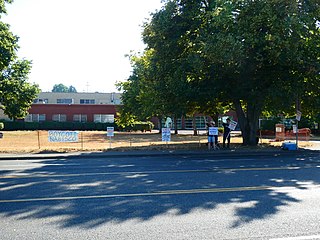
The Oregon Institute of Technology is a public polytechnic university in Oregon with a residential campus in Klamath Falls, Oregon, an urban campus in Wilsonville, Oregon, and additional locations in Salem and Seattle. Oregon Tech provides 32 degree programs in engineering, health technologies, management, communication, psychology, and applied sciences with a total of 37 majors. Almost all students complete externships, co-ops, or other hands-on training inside and outside the classroom.
Israel Kugler was a noted American professor of sociology. In the 1960s, he helped organize faculty at a number of New York City-area colleges and universities into labor unions. He co-founded the Professional Staff Congress, a union of faculty at the City University of New York (CUNY) which now represents more than 20,000 faculty and staff members at the university.
The St. John's University strike of 1966–1967 was a strike by faculty at St. John's University in New York City which began on January 4, 1966, and ended in June 1967. The strike began after 31 faculty members were dismissed in the fall of 1965 without due process, dismissals which some felt were a violation of the professors' academic freedom. The strike ended without any re-instatements, but led to the widespread unionization of public college faculty in the New York City area.
Cheryl B. Schrader is an American educator and former academic administrator. She began her presidency of Wright State University on July 1, 2017, and stepped down from the position December 31, 2019, midway through her five-year appointment. She was previously the chancellor of Missouri University of Science and Technology.

The Teaching Assistants Association (TAA) is a graduate student employee union formed at the University of Wisconsin–Madison in 1966. It is credited as the first graduate student labor union. Following voluntary recognition by the university as the teaching assistants' bargaining agent in 1969, negotiations resulted in a 1970 strike, which secured "bread-and-butter" gains such as job security alongside grievance procedures. Their major unmet demand from their strike—the inclusion of teaching assistants and students in the course planning process—went unfulfilled. The TAA struck again in 1980 and lost its union recognition until 1986. The union's protest at the Wisconsin State Capitol building began the 2011 Wisconsin protests.

The 2015 Kohler Strike is the fourth strike in the 142-year-old history of the Kohler Company in Kohler, Wisconsin.
The 2016–2017 video game voice actor strike was a strike started in October 2016 by the Screen Actors Guild‐American Federation of Television and Radio Artists (SAG-AFTRA) union against 11 American video game developers and publishers over failed contract renegotiation terms that had been in discussion since February 2015. Principally, the union sought to have actors and voice and motion capture artists that contribute to video games be better compensated with residuals based on video game sales atop their existing recording payments, while the industry companies asserted that the industry as a whole eschews the use of residuals, and by giving the actors these, they would trivialize the efforts of the programmers and artists that are most responsible for the development of the games. In exchange, the companies had offered a fixed increase in rates and a sliding-scale upfront bonus for multiple recording sessions, which the union had rejected. Other issues highlighted by the strike action include better transparency in what roles and conditions actors would perform, more safety precautions and oversight to avoid vocal stress for certain roles, and better safety assurances for actors while on set.
The Wright State University 2019 faculty strike was a strike organized by the Wright State chapter of the American Association of University Professors (AAUP) in response to employment conditions imposed by the university. The strike began on January 22, 2019, after nearly two years of failed contract negotiations between the AAUP and the Wright State University administration. The strike ended on February 10, 2019. At a length of twenty days, it was one of the longest faculty strikes in the history of U.S. higher education. University President Cheryl B. Schrader received widespread criticism for her handling of the strike and stepped down from her position as a result.
The 2020 University of Illinois Hospital strikes were the result of a breakdown in contract negotiations between labor unions and hospital management over salaries, staffing levels, and access to personal protective equipment.
The 2021 St. Charles Bend strike was a labor strike involving technical workers at the St. Charles Medical Center – Bend in Bend, Oregon, United States. The strike was precipitated when, in 2019, the workers at the hospital unionized with the Oregon Federation of Nurses and Health Professionals. Following this, the union's bargaining unit began to negotiate a labor contract between the workers and the hospital, with several dozen negotiating meetings following over the next year. By December 2020, however, both sides were at an impasse, and in February 2021, the union filed a strike notice. Despite legal challenges by the hospital, the strike commenced on March 4. On March 13, both sides agreed to a proposal by a federal mediator, with workers to return to work while both sides continued to negotiate a contract, with a deadline of March 31. The strike officially ended on March 15 and workers returned to the hospital. A contract was eventually ratified between the union and hospital by the end of that month.
The 2021–2022 Columbia University strike was a labor strike involving graduate student workers at Columbia University in New York City. The strike began on March 15, 2021, and ended on May 13, 2021. However, additional strike action commenced on November 3 and lasted until January 7, 2022, when a tentative agreement with the university was reached. The strike was organized by the Graduate Workers of Columbia–United Auto Workers Local 2110 (SWC–UAW), a labor union representing student workers at the university. The goals of the strike were an increase in wages, increased healthcare and childcare coverage, and third-party arbitration in cases of discrimination and sexual harassment.
The 2021 Go North West strike was a labour strike involving bus drivers working for Go North West, a bus operator in Greater Manchester, England, that lasted from 28 February to 18 May. The strike involved approximately 500 drivers unionised with Unite the Union and was caused by disagreements over the labour contracts between the company and employees.

The 2021 Nabisco strike was a labor strike involving workers for the American snack manufacturer Nabisco, a subsidiary of Mondelez International. The strike began at a Nabisco facility in Portland, Oregon on August 10 and over the next few days spread to several more Nabisco facilities throughout the United States.
The 1980 actors strike was a labor strike held in 1980 by the Screen Actors Guild and the American Federation of Television and Radio Artists, two labor unions representing actors in the American film industry. The strike was caused by a breakdown in labor contract negotiations between the two unions and representatives of film studios, television networks, and other independent producers. The primary point of contention regarded residuals from home media, such as videocassettes and pay television. Specifically, the union was seeking a form of profit sharing wherein they would receive a percentage of the revenue made from home media releases. Additionally, the unions wanted a 35 percent salary increase across the board for their members. By mid-July, the union and industry representatives were at an impasse, and the strike started on July 21. Several days later, the American Federation of Musicians also went on strike for similar reasons.
The 2021 Allegheny Technologies strike was a labor strike involving about 1,300 workers for metals manufacturing company Allegheny Technologies Incorporated (ATI), all unionized with the United Steelworkers (USW). The strike began on March 30 and ended on July 13 with the ratification of a new labor contract. Strikers returned to work by July 19. According to the Northwest Labor Press, the strike was among the country's largest for 2021 by number of strikers involved.
The 1985 Pan Am strike was a labor strike involving several thousand workers, all members of the Transport Workers Union of America (TWU), at Pan American World Airways. The strike began on February 28 and ended one month later on March 28.
The 2021 Virginia Volvo Trucks strike was a labor strike involving workers at a Volvo Trucks production facility in Dublin, Virginia, United States. The strike began in April and ended in July with the ratification of a new labor contract.
The 1979 Boston University strike was a labor strike involving employees at Boston University, a private university in Boston, Massachusetts, United States. The strike, involving faculty members, clerical workers, and librarians, began on April 5 and was fully ended by April 23.
The 2021 Mercy Hospital strike was a labor strike involving nurses and hospital workers at Mercy Hospital of Buffalo, in the United States. The strike began on October 1, 2021, and ended on November 4, 2021. It began following breakdown in collective bargaining negotiations between Communications Workers of America (CWA), the union representing the workers, and the Catholic Health network.
The 2021 Heaven Hill strike was a labor strike involving about 420 workers for the Heaven Hill bourbon whiskey distillery in Bardstown, Kentucky, United States. These workers are members of the United Food and Commercial Workers Local 23D and were on strike since September 11. The labor dispute is over the terms of a new five-year labor contract between the union and the company, which is one of the largest bourbon producers in the world. In particular, union members were concerned about "gray areas" in the contract that they believed could lead to union employees working weekends and extra overtime without pay. Additional concerns from the union were over reduced take-home pay and a removal of the limit on premiums for health care insurance. On September 9, union members voted by about 96 percent to reject the proposed contract and authorized strike action. As a result, the union's existing contract expired without replacement on September 10 and striking commenced the following day.




